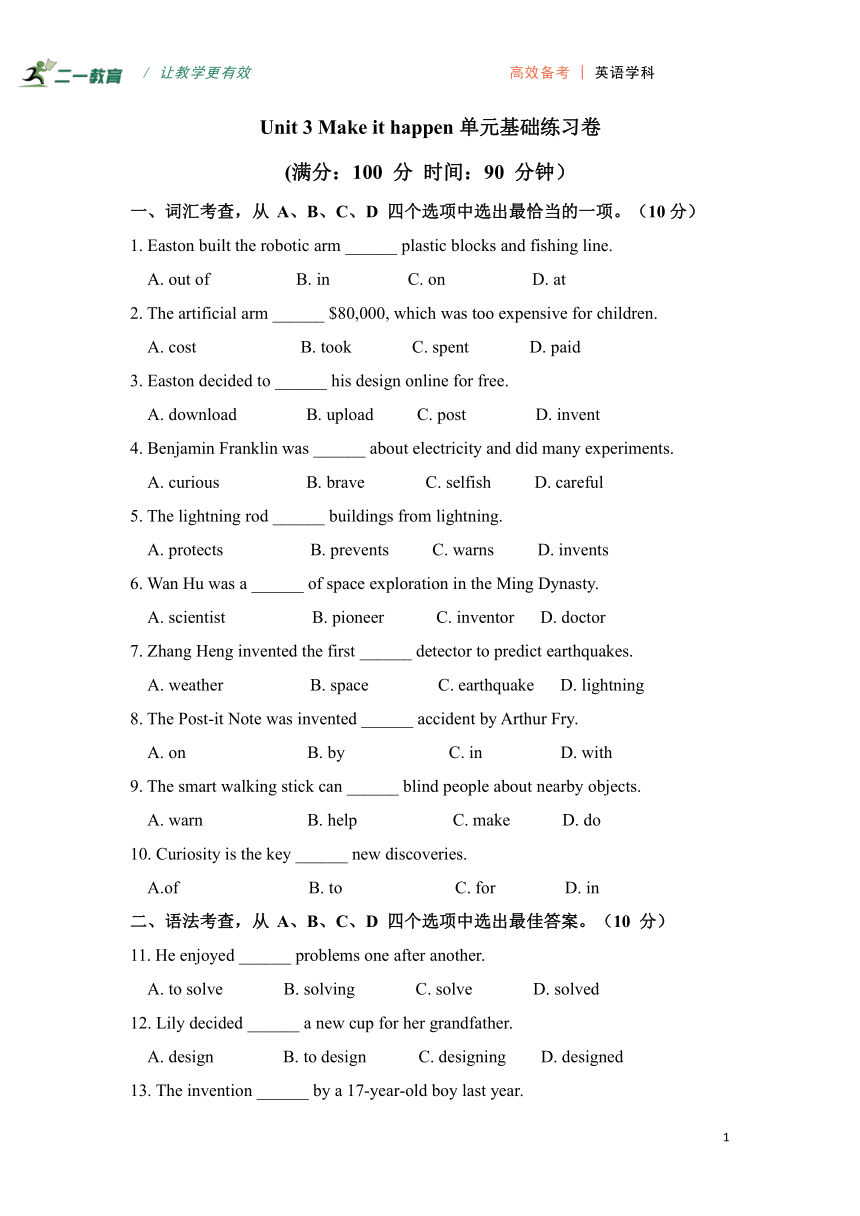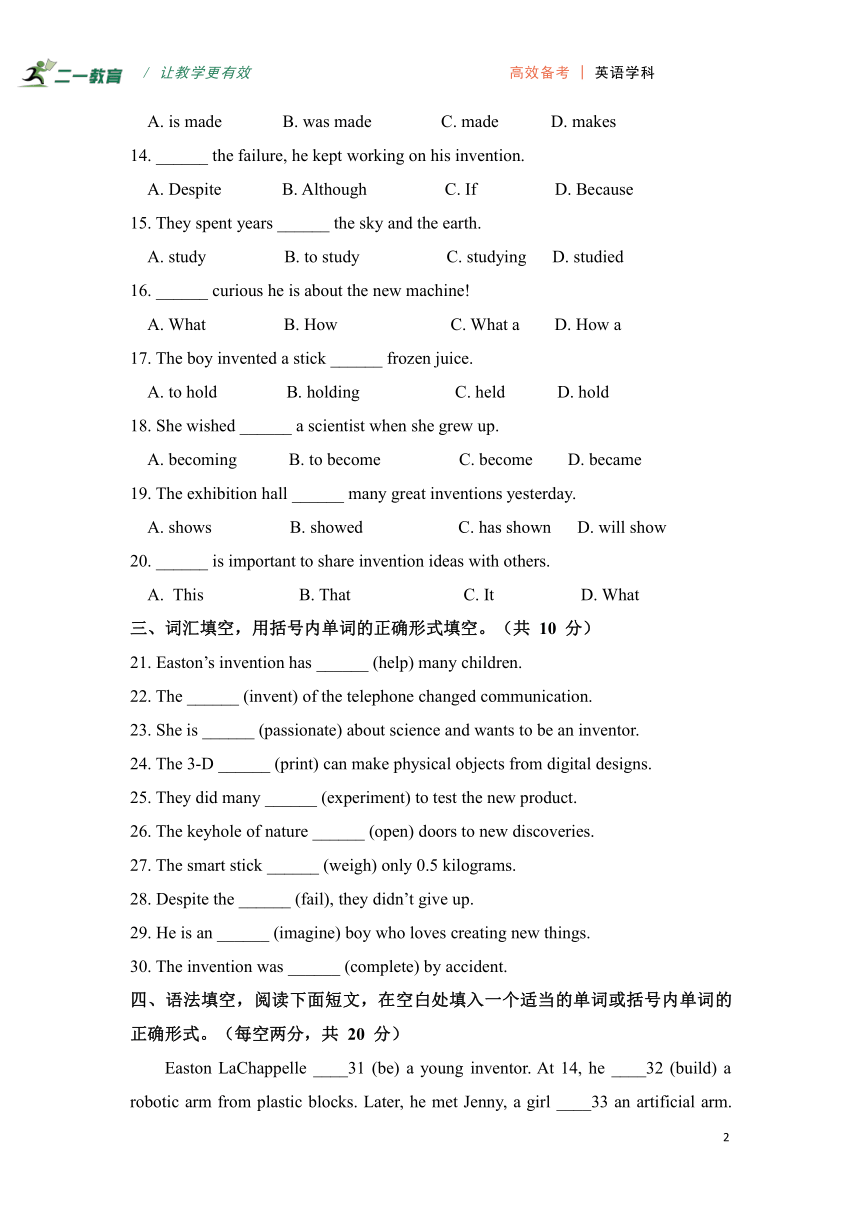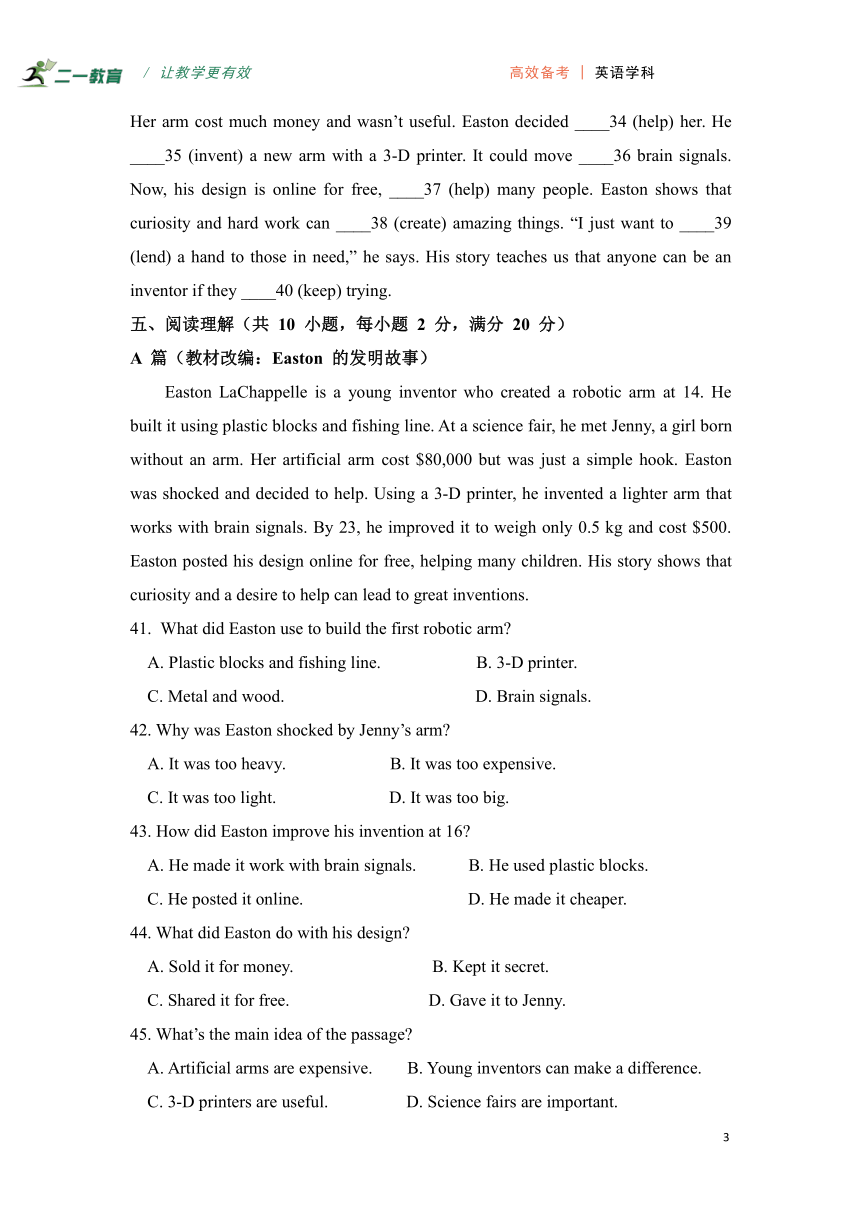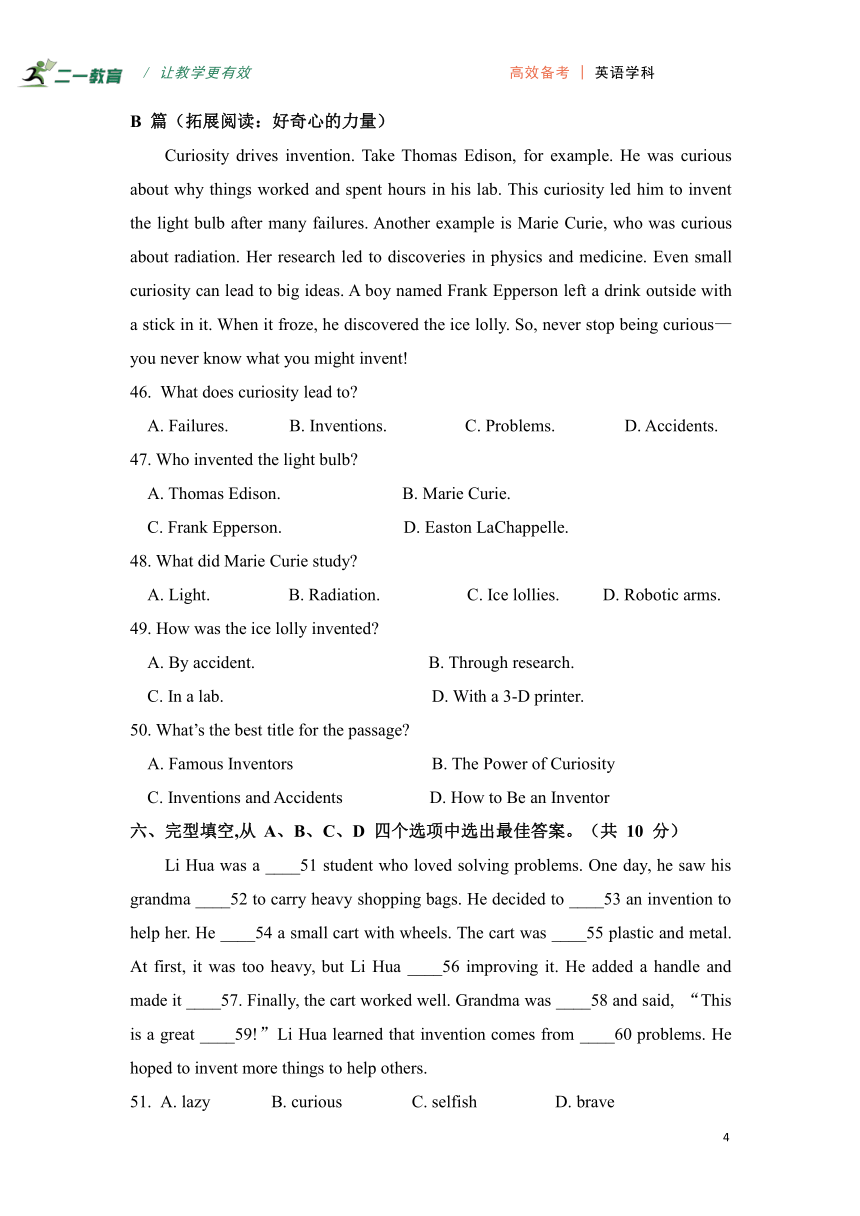 资源简介
资源简介
/ 让教学更有效 高效备考 | 英语学科
Unit 3 Make it happen单元基础练习卷
(满分:100 分 时间:90 分钟)
一、词汇考查,从 A、B、C、D 四个选项中选出最恰当的一项。(10分)
1. Easton built the robotic arm ______ plastic blocks and fishing line.
A. out of B. in C. on D. at
2. The artificial arm ______ $80,000, which was too expensive for children.
A. cost B. took C. spent D. paid
3. Easton decided to ______ his design online for free.
A. download B. upload C. post D. invent
4. Benjamin Franklin was ______ about electricity and did many experiments.
A. curious B. brave C. selfish D. careful
5. The lightning rod ______ buildings from lightning.
A. protects B. prevents C. warns D. invents
6. Wan Hu was a ______ of space exploration in the Ming Dynasty.
A. scientist B. pioneer C. inventor D. doctor
7. Zhang Heng invented the first ______ detector to predict earthquakes.
A. weather B. space C. earthquake D. lightning
8. The Post-it Note was invented ______ accident by Arthur Fry.
A. on B. by C. in D. with
9. The smart walking stick can ______ blind people about nearby objects.
A. warn B. help C. make D. do
10. Curiosity is the key ______ new discoveries.
A.of B. to C. for D. in
二、语法考查,从 A、B、C、D 四个选项中选出最佳答案。(10 分)
11. He enjoyed ______ problems one after another.
A. to solve B. solving C. solve D. solved
12. Lily decided ______ a new cup for her grandfather.
A. design B. to design C. designing D. designed
13. The invention ______ by a 17-year-old boy last year.
A. is made B. was made C. made D. makes
14. ______ the failure, he kept working on his invention.
A. Despite B. Although C. If D. Because
15. They spent years ______ the sky and the earth.
A. study B. to study C. studying D. studied
16. ______ curious he is about the new machine!
A. What B. How C. What a D. How a
17. The boy invented a stick ______ frozen juice.
A. to hold B. holding C. held D. hold
18. She wished ______ a scientist when she grew up.
A. becoming B. to become C. become D. became
19. The exhibition hall ______ many great inventions yesterday.
A. shows B. showed C. has shown D. will show
20. ______ is important to share invention ideas with others.
This B. That C. It D. What
三、词汇填空,用括号内单词的正确形式填空。(共 10 分)
21. Easton’s invention has ______ (help) many children.
22. The ______ (invent) of the telephone changed communication.
23. She is ______ (passionate) about science and wants to be an inventor.
24. The 3-D ______ (print) can make physical objects from digital designs.
25. They did many ______ (experiment) to test the new product.
26. The keyhole of nature ______ (open) doors to new discoveries.
27. The smart stick ______ (weigh) only 0.5 kilograms.
28. Despite the ______ (fail), they didn’t give up.
29. He is an ______ (imagine) boy who loves creating new things.
30. The invention was ______ (complete) by accident.
四、语法填空,阅读下面短文,在空白处填入一个适当的单词或括号内单词的正确形式。(每空两分,共 20 分)
Easton LaChappelle ____31 (be) a young inventor. At 14, he ____32 (build) a robotic arm from plastic blocks. Later, he met Jenny, a girl ____33 an artificial arm. Her arm cost much money and wasn’t useful. Easton decided ____34 (help) her. He ____35 (invent) a new arm with a 3-D printer. It could move ____36 brain signals. Now, his design is online for free, ____37 (help) many people. Easton shows that curiosity and hard work can ____38 (create) amazing things. “I just want to ____39 (lend) a hand to those in need,” he says. His story teaches us that anyone can be an inventor if they ____40 (keep) trying.
五、阅读理解(共 10 小题,每小题 2 分,满分 20 分)
A 篇(教材改编:Easton 的发明故事)
Easton LaChappelle is a young inventor who created a robotic arm at 14. He built it using plastic blocks and fishing line. At a science fair, he met Jenny, a girl born without an arm. Her artificial arm cost $80,000 but was just a simple hook. Easton was shocked and decided to help. Using a 3-D printer, he invented a lighter arm that works with brain signals. By 23, he improved it to weigh only 0.5 kg and cost $500. Easton posted his design online for free, helping many children. His story shows that curiosity and a desire to help can lead to great inventions.
What did Easton use to build the first robotic arm
A. Plastic blocks and fishing line. B. 3-D printer.
C. Metal and wood. D. Brain signals.
42. Why was Easton shocked by Jenny’s arm
A. It was too heavy. B. It was too expensive.
C. It was too light. D. It was too big.
43. How did Easton improve his invention at 16
A. He made it work with brain signals. B. He used plastic blocks.
C. He posted it online. D. He made it cheaper.
44. What did Easton do with his design
A. Sold it for money. B. Kept it secret.
C. Shared it for free. D. Gave it to Jenny.
45. What’s the main idea of the passage
A. Artificial arms are expensive. B. Young inventors can make a difference.
C. 3-D printers are useful. D. Science fairs are important.
B 篇(拓展阅读:好奇心的力量)
Curiosity drives invention. Take Thomas Edison, for example. He was curious about why things worked and spent hours in his lab. This curiosity led him to invent the light bulb after many failures. Another example is Marie Curie, who was curious about radiation. Her research led to discoveries in physics and medicine. Even small curiosity can lead to big ideas. A boy named Frank Epperson left a drink outside with a stick in it. When it froze, he discovered the ice lolly. So, never stop being curious—you never know what you might invent!
What does curiosity lead to
A. Failures. B. Inventions. C. Problems. D. Accidents.
47. Who invented the light bulb
A. Thomas Edison. B. Marie Curie.
C. Frank Epperson. D. Easton LaChappelle.
48. What did Marie Curie study
A. Light. B. Radiation. C. Ice lollies. D. Robotic arms.
49. How was the ice lolly invented
A. By accident. B. Through research.
C. In a lab. D. With a 3-D printer.
50. What’s the best title for the passage
A. Famous Inventors B. The Power of Curiosity
C. Inventions and Accidents D. How to Be an Inventor
六、完型填空,从 A、B、C、D 四个选项中选出最佳答案。(共 10 分)
Li Hua was a ____51 student who loved solving problems. One day, he saw his grandma ____52 to carry heavy shopping bags. He decided to ____53 an invention to help her. He ____54 a small cart with wheels. The cart was ____55 plastic and metal. At first, it was too heavy, but Li Hua ____56 improving it. He added a handle and made it ____57. Finally, the cart worked well. Grandma was ____58 and said, “This is a great ____59!”Li Hua learned that invention comes from ____60 problems. He hoped to invent more things to help others.
A. lazy B. curious C. selfish D. brave
A. easy B. happy C. struggling D. excited
A. buy B. invent C. borrow D. sell
A. built B. bought C. found D. drew
A. made of B. made from C. made in D. made up
A. stopped B. kept C. hated D. forgot
A. heavier B. lighter C. bigger D. smaller
A. sad B. angry C. happy D. worried
A. problem B. invention C. cart D. bag
A. solving B. creating C. finding D. ignoring
七、书面表达(15 分)
以 “My Favorite Invention” 为题,写一篇 80 词短文,介绍你最喜欢的发明(如手机、自行车等),使用词汇如 invent, useful, solve, improve 等。
答案与解析
一、词汇选择
1. A 解析:out of 意为 “由…… 制成”,符合课文搭配 “built it out of plastic blocks”。
2. A 解析:cost 表示 “价格为”,主语为物,符合语境。
3. C 解析:post 意为 “发布”,与课文中 “post his design online” 一致。
4. A 解析:be curious about 为固定搭配,意为 “对…… 好奇”。
5. A 解析:protect...from... 意为 “保护…… 免受……”,符合富兰克林发明避雷针的作用。
6. B 解析:pioneer 意为 “先驱”,课文中提到万户是太空探索先驱。
7. C 解析:根据课文,张衡发明地动仪,选 earthquake。
8. B 解析:by accident 为固定短语,意为 “偶然地”。
9. A 解析:warn sb. about sth. 意为 “提醒某人注意某事”,符合语境。
10. B 解析:the key to... 意为 “…… 的关键”,固定搭配。
二、语法选择
11. B 解析:enjoy doing sth. 为固定用法,用动名词 solving。
12. B 解析:decide to do sth. 为固定结构,用不定式 to design。
13. B 解析:last year 提示过去时,被动语态结构为 was made。
14. A 解析:despite + 名词,表 “尽管”,符合语境。
15. C 解析:spend time doing sth. 为固定用法,用动名词 studying。
16. B 解析:how 引导感叹句,修饰形容词 curious。
17. A 解析:不定式 to hold 作目的状语,意为 “用来握住”。
18. B 解析:wish to do sth. 为固定结构,用不定式 to become。
19. B 解析:yesterday 提示过去时,用 showed。
20. C 解析:it 作形式主语,真正主语为不定式 to share...。
三、词汇填空
21. helped 解析:现在完成时结构 has + 过去分词。
22. invention 解析:名词形式,意为 “发明”。
23. passionate 解析:形容词作表语,be passionate about 意为 “对…… 热情”。
24. printer 解析:名词,意为 “打印机”。
25. experiments 解析:many 后接可数名词复数。
26. opens 解析:一般现在时,主语为单数,动词用第三人称单数形式。
27. weighs 解析:一般现在时,主语为单数,动词用第三人称单数形式。
28. failure 解析:名词形式,作宾语。
29. imaginative 解析:形容词,意为 “富有想象力的”。
pletely 解析:副词修饰动词,意为 “完全地”。
四、语法填空
31. is 解析:客观事实,用一般现在时。
32. built 解析:过去时间点,用过去式。
33. without 解析:根据课文,Jenny 天生没有手臂,用 without。
34. to help 解析:decide to do sth. 固定结构。
35. invented 解析:过去动作,用过去式。
36. with 解析:表示 “通过脑信号”,用 with。
37. helping 解析:现在分词作状语,表结果。
38. create 解析:情态动词 can 后接动词原形。
39. lend 解析:want to do sth. 固定结构,lend a hand 意为 “帮助”。
40. keep 解析:条件状语从句用一般现在时表将来。
五、阅读理解
A 篇
41. A 解析:文中明确提到用 plastic blocks 和 fishing line 制作。
42. B 解析:Jenny 的假肢昂贵($80,000)且功能简单,令 Easton 震惊。
43. A 解析:16 岁时发明的假肢可用脑信号控制,对应文中 “move with brain signals”。
44. C 解析:他将设计免费发布到网上,帮助更多人。
45. B 解析:全文讲述 Easton 作为年轻发明家带来的影响,选 B。
B 篇
46. B 解析:短文首句指出好奇心驱动发明,故选 B。
47. A 解析:爱迪生发明电灯泡,文中明确提到。
48. B 解析:居里夫人研究辐射(radiation),对应文中描述。
49. A 解析:Frank Epperson 偶然发明冰棍,文中提到 “left...outside...froze”。
50. B 解析:全文围绕好奇心的力量展开,选 B。
六、完形填空
51. B 解析:根据语境,Li Hua 爱解决问题,应为 “好奇的”(curious)。
52. C 解析:奶奶提重物 “费力”,用 struggling。
53. B 解析:决定 “发明” 工具帮助奶奶,用 invent。
54. A 解析:“制作” 手推车,用 built。
55. A 解析:由塑料和金属制成,看得出原材料用 made of。
56. B 解析:keep doing sth. 持续做某事,符合 “不断改进” 语境。
57. B 解析:之前太重,改进后更 “轻”(lighter)。
58. C 解析:奶奶对发明感到 “高兴”(happy)。
59. B 解析:称赞这是伟大的 “发明”(invention)。
60. A 解析:发明源于 “解决”(solving)问题。
七、书面表达(参考范文)
My Favorite Invention
My favorite invention is the mobile phone. It was invented to help people communicate better. Before mobile phones, people had to write letters or use public phones. Now, we can call, text, and even video chat with others anywhere. It also solves problems like finding directions or learning new things through apps. The mobile phone has improved our lives greatly. It connects people and makes the world smaller. I believe it’s one of the most useful inventions in history.
展开更多......
收起↑
 资源预览
资源预览




 资源预览
资源预览



